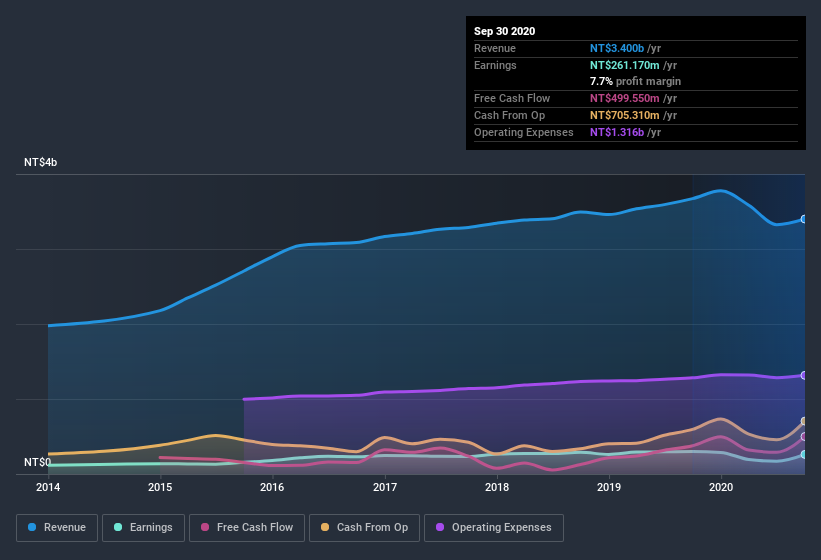- Taiwan
- /
- Hospitality
- /
- TPEX:1268
We Think Hi-Lai Foods's (GTSM:1268) Statutory Profit Might Understate Its Earnings Potential

It might be old fashioned, but we really like to invest in companies that make a profit, each and every year. Having said that, sometimes statutory profit levels are not a good guide to ongoing profitability, because some short term one-off factor has impacted profit levels. Today we'll focus on whether this year's statutory profits are a good guide to understanding Hi-Lai Foods (GTSM:1268).
While Hi-Lai Foods was able to generate revenue of NT$3.40b in the last twelve months, we think its profit result of NT$261.2m was more important. One positive is that it has grown both its profit and its revenue, over the last few years, though not in the last twelve months.
See our latest analysis for Hi-Lai Foods

Not all profits are equal, and we can learn more about the nature of a company's past profitability by diving deeper into the financial statements. As a result, we think it's well worth considering what Hi-Lai Foods' cashflow (when compared to its earnings) can tell us about the nature of its statutory profit. Note: we always recommend investors check balance sheet strength. Click here to be taken to our balance sheet analysis of Hi-Lai Foods.
A Closer Look At Hi-Lai Foods' Earnings
One key financial ratio used to measure how well a company converts its profit to free cash flow (FCF) is the accrual ratio. The accrual ratio subtracts the FCF from the profit for a given period, and divides the result by the average operating assets of the company over that time. You could think of the accrual ratio from cashflow as the 'non-FCF profit ratio'.
Therefore, it's actually considered a good thing when a company has a negative accrual ratio, but a bad thing if its accrual ratio is positive. While having an accrual ratio above zero is of little concern, we do think it's worth noting when a company has a relatively high accrual ratio. To quote a 2014 paper by Lewellen and Resutek, "firms with higher accruals tend to be less profitable in the future".
For the year to September 2020, Hi-Lai Foods had an accrual ratio of -1.04. Therefore, its statutory earnings were very significantly less than its free cashflow. Indeed, in the last twelve months it reported free cash flow of NT$500m, well over the NT$261.2m it reported in profit. Hi-Lai Foods' free cash flow improved over the last year, which is generally good to see.
Our Take On Hi-Lai Foods' Profit Performance
Happily for shareholders, Hi-Lai Foods produced plenty of free cash flow to back up its statutory profit numbers. Based on this observation, we consider it possible that Hi-Lai Foods' statutory profit actually understates its earnings potential! And the EPS is up 8.4% annually, over the last three years. At the end of the day, it's essential to consider more than just the factors above, if you want to understand the company properly. If you want to do dive deeper into Hi-Lai Foods, you'd also look into what risks it is currently facing. In terms of investment risks, we've identified 1 warning sign with Hi-Lai Foods, and understanding this should be part of your investment process.
This note has only looked at a single factor that sheds light on the nature of Hi-Lai Foods' profit. But there is always more to discover if you are capable of focussing your mind on minutiae. Some people consider a high return on equity to be a good sign of a quality business. So you may wish to see this free collection of companies boasting high return on equity, or this list of stocks that insiders are buying.
If you’re looking to trade Hi-Lai Foods, open an account with the lowest-cost* platform trusted by professionals, Interactive Brokers. Their clients from over 200 countries and territories trade stocks, options, futures, forex, bonds and funds worldwide from a single integrated account. Promoted
Valuation is complex, but we're here to simplify it.
Discover if Hi-Lai Foods might be undervalued or overvalued with our detailed analysis, featuring fair value estimates, potential risks, dividends, insider trades, and its financial condition.
Access Free AnalysisThis article by Simply Wall St is general in nature. It does not constitute a recommendation to buy or sell any stock, and does not take account of your objectives, or your financial situation. We aim to bring you long-term focused analysis driven by fundamental data. Note that our analysis may not factor in the latest price-sensitive company announcements or qualitative material. Simply Wall St has no position in any stocks mentioned.
*Interactive Brokers Rated Lowest Cost Broker by StockBrokers.com Annual Online Review 2020
Have feedback on this article? Concerned about the content? Get in touch with us directly. Alternatively, email editorial-team@simplywallst.com.
About TPEX:1268
Adequate balance sheet second-rate dividend payer.
Market Insights
Community Narratives



